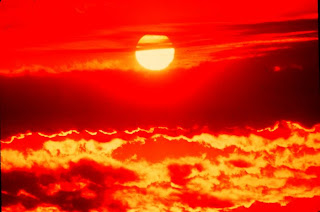
The people, buildings and overall landscape were completely obliterated. The four major components of the A-Bomb are Energy, Heat, Blast and Radiation. When combined the result is devastating.
Energy generated by the explosion The atomic bomb dropped on Hiroshima generated a huge amount of energy when it exploded. The amount of energy generated by the bomb was equivalent to the amount of energy generated by a 15-kiloton TNT explosion. Half of the energy was consumed when the explosion generated an ultra high air pressure which resulted in very strong bomb blast (wind). One third of the energy was consumed when the explosion generated heat, while the rest of the energy was consumed when the explosion generated radiation.

Heat On the ground, beneath the explosion center(hypocenter), the temperature rose to approximately 7,000 degree F. On the stairway of the entrance to a bank, which was 1/8 mile from the explosion center, a man was sitting waiting for its opening. The surface of the stone stairway was changed by the immense heat. The part where the man was sitting remained unchanged because his body absorbed the heat. Roof (ceramic) tiles on houses within 1/3 mile radius from the explosion center melted, and gray stones which contained silicon particles became white. The clothes which people wore were burnt by the heat within 1 1/4 mile radius from the explosion center.

( Bomb Blast)
Bomb blast An ultra high pressure was generated by the explosion. The wind velocity on the ground beneath the explosion center was 980 miles/hr, which is five times stronger than the wind generated by strong hurricanes. The pressure was 3.5 kg per square centi-meter which is equivalent to 8,600 pound per square feet. At a point that was 1/3 mile from the explosion center, the wind velocity was 620 miles/hr; the pressure was 4,600 pound per square feet. Most of concrete buildings inside this range were completely destroyed. Even a mile from the explosion center, where the wind velocity was 190 miles/hr and the pressure was 1,180 pound per square feet, all brick buildings were completely destroyed.

Radiation The explosion generated Alpha, Beta, Gamma and neutron rays. Alpha and Beta rays were absorbed by the air and did not reach to the ground. Gamma and neutron rays were strong enough to reach the ground; thus it was these rays that affected people. Within 1/16 mile radius from the explosion center, most people died within a few hours (even in the case where they were not directly exposed to the heat or wind). Within a half mile radius, most people died within 30 days after the explosion. The people who entered the area within a half mile radius from the explosion center in the first 100 hours after the explosion were also affected by the remaining radiation on the ground. Fortunately it has not been observed that the long term effects of radiation affected A-bomb survivors nor that a radiation exposure caused genetic damages.
Effects of Radiation-Early effects on survivors Within several months to several years after the atomic bombings. Summary Early effects include various acute radiation symptoms. Information on these symptoms was obtained by interviewing more than 100,000 atomic-bomb survivors primarily from 1956 to 1961. Survivor recollections of the traumatic day were highly subjective, possibly resulting in biased data regarding early effects. Among the acute radiation symptoms recalled by survivors, epilation (hair loss) is regarded as the most reliably reported. That is, it is considered to be more objectively remembered than other symptoms, such as vomiting, bleeding from the gums, diarrhea, and purpura. In general, acute radiation symptoms do not appear at low-dose radiation exposures, giving rise to a concept known as a threshold dose. That is, below a certain radiation dose, no acute symptoms occur. This is in contrast to a theory known as the linear dose-response relationship, which is illustrated by malignant diseases, one of the most well established late effects of radiation exposure. This concept implies that the higher the radiation dose, the greater the risk of developing a malignancy.
References: http://history.sandiego.edu/gen/st/~lovenson/Theeffects.html

0 comments:
Post a Comment